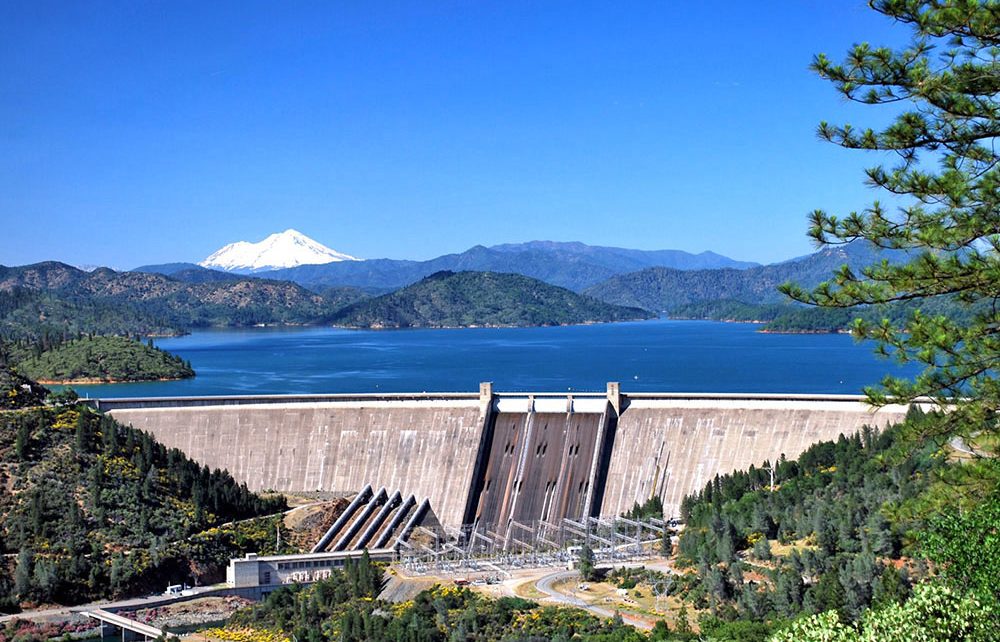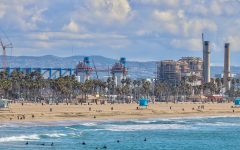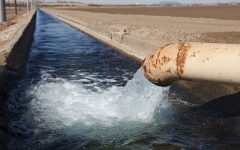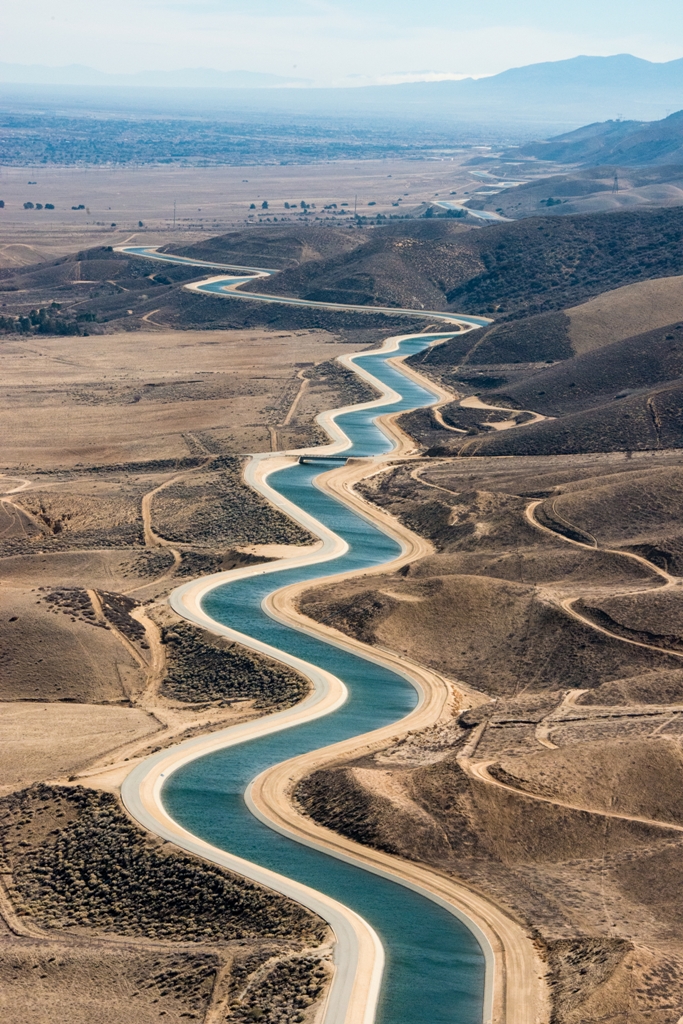
Shasta Dam Raising Project would heighten dam 18.5-feet. (Photo: U.S. Bureau of Reclamation)
Ringside: How Much Water Will $30 Billion Buy?
If raised, Shasta Dam could have been filled to capacity this year, and last year
By Edward Ring, April 10, 2024 2:20 pm
 So far this year I had the privilege of attending two water oriented events. The first, in February, was at the annual CalDesal conference in Sacramento. The second, in March, was at the Kern County Water Summit in Bakersfield. I sensed there is a growing recognition among the participants in both of these events that not only is California’s state water policy fundamentally broken, because it still prioritizes rationing instead of more projects to increase supply, but also that there is more potential today than ever for regional interests to work together to demand a new approach.
So far this year I had the privilege of attending two water oriented events. The first, in February, was at the annual CalDesal conference in Sacramento. The second, in March, was at the Kern County Water Summit in Bakersfield. I sensed there is a growing recognition among the participants in both of these events that not only is California’s state water policy fundamentally broken, because it still prioritizes rationing instead of more projects to increase supply, but also that there is more potential today than ever for regional interests to work together to demand a new approach.
Specifically, there is potential for water agencies and water users in California’s rural, agricultural San Joaquin Valley, to stand alongside water agencies and water users in Southern California’s megacities to promote a shared list of water supply projects that will eliminate water scarcity in the state forever. An incentive for this unity, and its urgency, may be found in what is about to be the greatest waste of money in California water history, the construction of the Delta Tunnel. A realistic, if not wildly optimistic cost estimate for that mega-project is $30 billion. That money could be used instead to help fund massive regional water projects. Split it 50/50: $15 billion for the farms, and $15 billion for the cities.
The Delta Tunnel, according to its own proponents, is only projected to deliver 500,000 acre feet of water per year to Southern California. Moreover, that is a gross number, since it is likely that use of the existing Delta pumps will be further restricted once water starts going through the tunnel. While the official cost estimate for the tunnel is $16 billion, California’s High Speed Rail project ought to provide a cautionary reality check. Does anyone sincerely believe it’s going to be possible to construct a tunnel 45 miles long with a 36 foot interior diameter, underneath one of the biggest estuaries in the world, for less than $30 billion?
Compared to other water supply project options, the Delta Tunnel does not make financial sense. Spending $30 billion to build something that will move 500,000 acre feet of water per year equates to $60,000 of capital cost per acre foot of annual yield. This is a terrible ratio.
For comparison, consider the proposed Temperance Flat Reservoir, for which the highest construction costs estimates came in at $3.5 billion. This reservoir would hold 1.3 million acre feet, and yet its detractors claimed its “yield” would only be 70,000 acre feet per year. Estimates vary, but even if that were true, at $50,000 in capital cost per acre foot of annual yield, it still beats the Delta Tunnel. And it would generate hydroelectric power. More recent evidence suggests that these biased estimates of its probable yield were low. Temperance Flat would have been full last year, and again this year.
In any case, Temperance Flat is one of the more expensive examples of surface storage options, yet it is clearly more cost effective than the Delta Tunnel. Consider the proposed Shasta Dam raise, for which engineering studies are already complete. Raising the height of the dam a mere 18 feet would increase storage in that vast lake by over 600,000 acre feet. And it, too, could have been filled to capacity this year, and last year.
Raising the height of the Shasta Dam attracts the same united chorus of opposition as Temperance Flat, but it makes so much sense that it continues to come up for discussion. A 2012 expert study claimed “dry year deliveries” from Lake Shasta would only increase by 76,000 acre feet. That’s not the average, of course. That’s worst case. But at an estimated cost of $1.8 billion (2024 dollars), that still equates to slightly less than $24,000 of capital cost per acre foot of annual yield, almost three times more cost-effective than the Delta Tunnel.
Other surface storage projects fall somewhere in between these estimates. All of them are better returns on investment compared to the Delta Tunnel. So what about desalination?
It is likely that if desalination plants were constructed at a larger scale, starting for example at 100,000 acre feet of annual capacity which is roughly twice the size of California’s existing plant in Carlsbad, the capital cost per acre foot of annual yield would be less. But as it is, referencing the inflation adjusted actual cost to build Carlsbad, and the more recent cost projections for the proposed plant in Huntington Beach, ocean desalination costs around $27,000 of capital cost per acre foot of annual yield.
The point here isn’t to proclaim desalination as a more cost-effective choice than surface storage. It probably isn’t on average. But it is a reliable water supply that is competitive with surface storage in dry years. More to the point is the fact that desalination, combined with upgraded wastewater treatment and urban runoff harvesting, all have the potential to significantly reduce the need for California’s big coastal cities to import water from the Central Valley. A $15 billion dollar investment in desalination would yield 550,000 acre feet per year, at a capital cost to annual yield ratio that is at least twice as favorable as that of the proposed Delta Tunnel. Putting that money into wastewater recycling instead would yield a comparable return. There is no serious water supply project option available to Californians that does not beat the Delta Tunnel in terms of return on investment.
Bear in mind the energy cost to pump water through seven pumping stations from the proposed tunnel entrance through southbound aqueducts and into Los Angeles is about 400 constant megawatts to move 1.0 million acre feet of water per year. That is almost exactly how much energy is required to desalinate an equivalent amount of salt water. Transporting fresh water over 500 miles, lifting it (cumulatively) over 2,000 feet, takes just as much energy per unit as ocean desalination. Just leave Diablo Canyon open. It generates five times that much in baseload electric power.
What proponents of desalination have to resist is the temptation to disparage surface storage options on environmental grounds while defending desalination against environmentalist objections. Ditto for the proponents of surface storage. They have to stop disparaging desalination while defending surface storage. Unite. Both solutions are necessary and feasible. The reasons environmentalists have been able to prevent major water supply infrastructure is largely due to a lack of sustained unanimity among proponents of infrastructure. At the heart of that needless schism is the mistaken idea that farm interests and urban interests are in inherent conflict.
Surface storage and desalination aren’t the only answers. Maybe there are better options. The San Joaquin Valley water agencies may be able instead to build fish friendly delta diversion filtration beds that would benignly transfer millions of acre feet per year of potential floodwaters into capacious quick-fill underground storage. Urban water districts may optimize stormwater harvesting in order to collect millions of acre feet more cost-effectively than desalination. What is certain is that conservation efforts have reached the point of diminishing returns. To achieve resiliency, or even abundance, we must agree to build ways to produce more water. Also certain? The Delta Tunnel is the worst option.
There’s $30 billion dollars up for grabs. Working together, urban and agricultural interests may be able to prevent it from being wasted. There’s still time. But they will have to agree on a list of projects that splits the money, and then they have to support each other’s proposals.
- Ringside: The Potential of Waste-to-Energy in California - April 17, 2024
- Ringside: How Much Water Will $30 Billion Buy? - April 10, 2024
- Ringside: Sacramento’s War on Water and Energy - April 4, 2024





To answer the question – If Noisome is in charge “not a drop”. Should they proceed with the delta tunnel it will make the choo-choo from no where to no where look like a bargain. I doubt a single foot of tunnel would actually be built for the $30 billion. They could spend that and more on overhead and environmental studies. With dams the work is all above ground and harder to fake and dams actually have a proven track record of storing vast amounts of water economically AND producing large amounts of power.
we can’t have that, can we. “…dams actually have a proven track record of storing vast amounts of water economically AND producing large amounts of power.”
Bet if you poke around in documents related to the tunnel you’ll find the name Pelosi, just as we did in the high speed rail project.